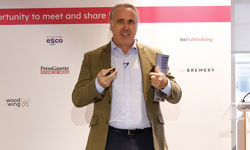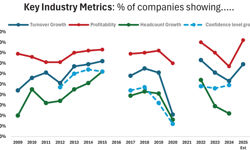One could be forgiven for thinking that launching a high profile fashion and beauty glossy in the middle of the worst recession in decades is, at best, high risk. But customer publishing giant John Brown's next big magazine launch has two immediate things going for it. It's for John Lewis Partnership, recently named Britain's best high street retailer by Which? And it's being developed by Marie O'Riordan, former editor of Marie Claire.
John Lewis Magazine - for the time being the final title remains under wraps - is a big deal both for the retailer and John Brown, recently named 'One to Watch' by Sunday Times Best Companies, which publishes titles including mobile phone company Orange's lifestyle magazine Together, Private Banking magazine for Royal Bank of Scotland, and Waitrose Food Illustrated. Launching on September 1, it will have a circulation of at least 500,000, average 120 pages per issue, and publish at least five times a year. It will also carry a significant proportion of third party advertising, with leading premium brands like Estee Lauder already showing an interest.
The rationale
"John Lewis is all about celebrating the pleasure of the everyday," O'Riordan explains. "It is commonly associated in many people's minds with the home, but fashion is a fast-growing area for the business." Tanya Sarne, founder and designer of the Ghost label, for example, has recently created an exclusive fashion line for the retailer called Tanya Sarne for John Lewis. "The magazine will reflect this with a strong focus on fashion and beauty as well as homes, travel and real people. The theme is shopping intelligence, but we also want people to reassess their perceptions of the John Lewis brand. It's about deepening the customer relationship, and the intention is to encourage the John Lewis shopper to visit not just one department but three, extending the time they spend in-store."
The new title boasts an impressive line-up of contributors including Jess Cartner Morley, Jeremy Langmead, India Knight, Zoe Williams, Toby Young and Miranda Sawyer and will be edited by one-time Minx editor Vanessa Thompson, until recently deputy editor of Marie Claire. The involvement of all is testament to the power of the John Lewis brand and the appeal of the glossy dummy O'Riordan created. It will be produced by the John Brown team behind Source, the bi-monthly title John Brown developed for John Lewis' financial division, Greenbee, which is being folded into the new title. And it has ambitions to make a mark beyond the John Lewis stores through which it will be distributed, with an ambitious design awards scheme developed to encourage new talent from fashion, textiles, and industrial design due to be launched by the magazine in partnership with selected colleges during 2010.
Leaving Marie Claire
Not bad going for a concept O'Riordan readily admits she "pretty much invented" at her kitchen table in Norfolk last January.
It began with her decision last summer to leave Marie Claire where she had been editor for seven years. During this time she had famously become the first editor to put a man on the cover when she invited David Beckham to be photographed and interviewed for a story in May 2002. Under the latter years of her stewardship, however, sales of the so-called 'thinking woman's glossy' had begun to slip as conditions toughened across the women's magazines market. The IPC title suffered a circulation fall of 4.8% year-on-year in the second half of 2008.
"Leaving Marie Claire was a personal decision rather than a professional one," she recalls. "I'd been feeling ready for a change for a while having overseen three reinventions of the title. I was on the Marie Claire board at the time - we were discussing the magazine market around the world and where it was going in preparation for a major research project which would inevitably lead to further change - and I realised I just didn't have the heart for it. I thought it was time for a change, that I might even try newspapers (rather foolishly, as it turned out, given how the market has fared in the months since) or maybe a book."
With a CV that also boasted editorships of More! and Elle as well as a period as group publishing director responsible for Emap's youth division overseeing titles including Bliss and J17, O'Riordan was confident she could pick up some kind of consultancy work. She was right. Soon after leaving Marie Claire in December 2008 with no firm plans, she was approached by John Brown to help on the John Lewis Magazine pitch. Then, having led the team that won the business, she accepted a role as John Brown's editor-in-chief.
It is, O'Riordan believes, an exciting time to be in magazines despite the difficult economic situation all publishers now find themselves in.
"In a recession you have to hunker down, cut costs and ride it out. But you also have to adapt. I went through the last recession on More! and we got through with a clear focus on readers' needs and real life stories. It's a slightly different story on a glossy, of course, because of the dependence on fantasy to sell. But with Vogue bringing back ‘More Dash than Cash’, it's clear no-one can afford to stand still. Yes, they still have fantasy fashion, but they have to acknowledge what's happening in the world outside," she says.
Too many me-toos
Judging by recent trends in women's consumer magazines, moving forwards, O'Riordan predicts further closures - but not just because of the recession.
"There were too many titles, women's glossies included, and many were too same-y," she believes. "You have to have a USP and that USP must be very clear. Editors like me used to be torn by having free gifts on the cover because there was always doubt over whether the reader was buying you for the free flip-flops or for the exclusive inside on Cherie Blair. Did publishers inadvertently cause disloyalty amongst their readership by over-doing the free giveaway? It's an interesting question."
In contrast, customer publishing now seems far better-positioned to weather the storm. Latest ABC figures show there was a 16% rise in customer titles' circulations in the second half of 2008 - a period during which total circulation of consumer titles slumped 6.7% - and the reason, O'Riordan suggests, is customer publishing's focus on creativity and flexibility.
A dynamic and creative sector
"Magazine teams within the contract sector tend to be leaner and more agile. I have found people at John Brown move quickly and easily between different sectors, like a set of SWAT teams. You just don't get that in consumer publishing where people are very much tied to individual titles, and, over time, people and thinking can become institutionalised," she says.
"Although I'm completely new to customer publishing, it is clear that things have never been busier. In an economic crisis, smart clients want to get close to their customers and a magazine is an ideal way to do so - a direct conduit through which they can buy themselves 20 minutes of someone's time. Cost-cutting is one way of coping with a downturn. But if you are a company with vision, then you must think five to ten years ahead, and that means investing where appropriate to deepen the customer relationship."
She's finding life at John Brown can be, at times, more creative, too.
"If you're producing a magazine for the newsstand, the focus is, inevitably, on your competitors - a publishing director will come up to you and say 'They've done this, why haven't we?' Which is ironic, as in customer publishing the approach is the reverse. Our focus here is on unique, individual products and the approach is uber-creative. The good thing is that both customers and readers seem to value it and this, along with the lack of emphasis on focus group research when developing a new product, is really very liberating."
Though she won't rule out a return to consumer publishing at some point in the future, O'Riordan insists her focus for now is on bringing John Lewis Magazine to fruition and developing further products for other John Brown clients both old and new. The title will provide the business with an interesting marker, she believes: "As John Brown's first fashion glossy, it is a significant departure, and it will demonstrate to everyone just what the company can achieve, as producing a successful fashion glossy is an extremely difficult thing to do."










